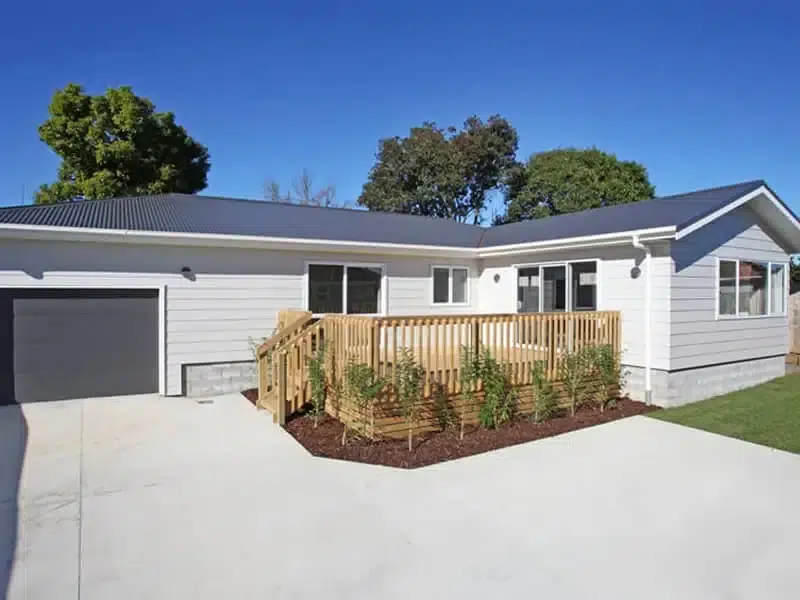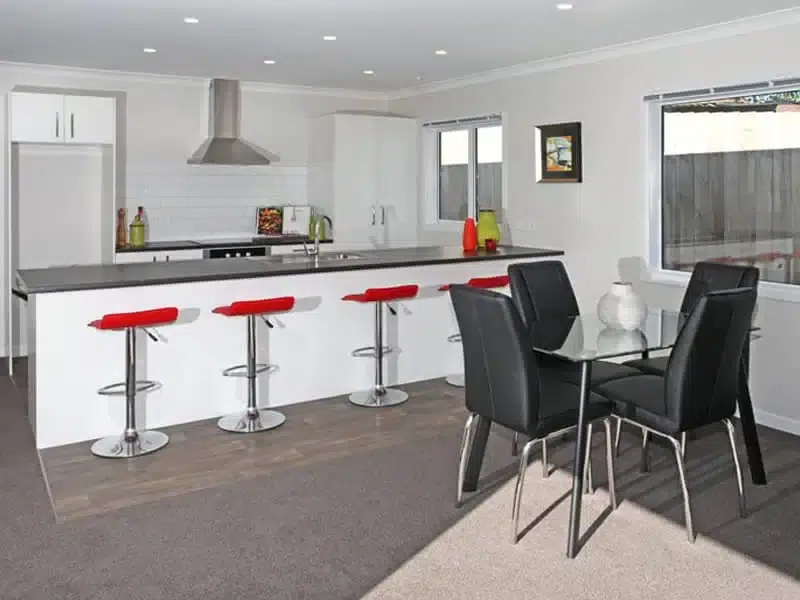
Before we start, if you’re looking for a broader overview of the renovation process, check out our complete home renovation guide. Now, let’s look at what goes into the cost of a full home renovation.
Understanding Full Home Renovation Costs
Your choice of materials greatly affects the overall expense. Opting for high-end finishes will increase costs, while more budget-friendly options can help keep expenses down. The extent of structural changes needed is another crucial factor. Moving walls or altering the layout of your home requires more work and often involves additional professionals like engineers, which adds to the cost.
For example, choosing solid wood flooring over laminate can significantly impact your budget. Similarly, custom-made cabinetry will cost more than off-the-shelf options.
The extent of structural changes needed is another crucial factor. Moving walls or altering the layout of your home requires more work and often involves additional professionals like engineers, which adds to the cost. These changes might also necessitate updates to your home’s electrical, plumbing, or HVAC systems, further increasing expenses.
Labour costs also play a part in the total price of your renovation. These can fluctuate based on demand and the specific skills required for your project. Specialised trades like electricians or plumbers often command higher rates than general labourers. The complexity of your project and the time it takes to complete will directly impact labour costs.
It’s worth noting that a full home renovation in Franklin can span a wide range of costs, reflecting these various factors. To get a realistic estimate for your specific project, it’s best to consult with local contractors familiar with Franklin’s market conditions and building regulations.

Breaking Down the Costs: Major Renovation Areas
The kitchen often represents a significant portion of a full home renovation budget. This space typically requires a mix of skilled labour and expensive materials. Costs here include cabinetry, countertops, appliances, flooring, and often plumbing and electrical work. The layout of your kitchen and the quality of finishes you choose will greatly influence the final cost.
For instance, a minor kitchen refresh might involve replacing cabinet fronts and upgrading appliances. A major renovation could include changing the layout, installing high-end appliances, and adding luxury features like a kitchen island or custom lighting.
Remember to factor in the cost of any specialised appliances you might want, such as a gas cooktop or a wine fridge. These can add significantly to your overall budget but might be worth the investment if you’re a keen cook or entertainer.
Bathroom Renovation Costs:
Bathrooms, like kitchens, can be costly to renovate due to the mix of trades required. Plumbing, tiling, and fixtures all contribute to the expense. The number of bathrooms you’re updating and any layout changes will affect your overall costs. Adding luxury items like heated floors or high-end showers can quickly increase the budget for these spaces.
Consider the cost of waterproofing, which is crucial in bathrooms to prevent water damage. This is an area where cutting corners can lead to expensive problems down the line, so it’s worth investing in quality materials and skilled labour.
Living Areas and Bedrooms:
While often less costly than kitchens and bathrooms, living areas and bedrooms still contribute significantly to a full home renovation. Costs here might include new flooring, paint, lighting, and potentially built-in storage solutions. If you’re making structural changes, such as removing walls to create open-plan spaces, this will add to the expense.
Consider the cost of window treatments, which can be surprisingly expensive but make a big difference to the look and feel of a room. Similarly, updating your home’s lighting can significantly impact the ambiance and functionality of these spaces.
Exterior Renovations:
Don’t forget the outside of your home when budgeting for a full renovation. This might include new cladding, roofing, windows, or landscaping. These elements not only improve your home’s appearance but can also enhance its energy efficiency and overall value. The size of your property and the materials chosen will drive costs in this area.
Re-cladding your home can be a significant expense, but it can dramatically improve your home’s insulation and weather resistance. Similarly, upgrading to double-glazed windows might be costly upfront but can lead to long-term savings on energy bills.
Landscaping is another area that can vary widely in cost depending on your plans. Simple garden beds and lawn areas are relatively inexpensive, while features like decks, patios, or water features can add significantly to your budget.
Hidden Costs and Often Overlooked Expenses
You might need to factor in temporary accommodation costs if your renovation makes your home unlivable for a period. This could mean renting a property or staying in a hotel, which can quickly add up over weeks or months.
The cost of permits can vary depending on the scope of your project and your local council’s fees. It’s important to factor these in early, as failing to obtain the necessary permits can lead to costly delays or even fines.
Consider whether you have friends or family you could stay with to minimise these costs.
Unforeseen structural issues often crop up during renovations, especially in older homes. You might discover problems like asbestos, outdated wiring, or plumbing that needs replacement. It’s wise to set aside a contingency fund of about 10-20% of your total budget for these unexpected expenses.
Other often overlooked costs include:
- Storage fees for furniture and belongings during the renovation
- Increased insurance premiums during and after the renovation
- Costs for professional cleaning once the renovation is complete
- Potential increases in property taxes due to the increased value of your home
Cost-Saving Strategies for Full Home Renovations
Create a detailed renovation plan that spans several years. This approach allows you to focus on one area at a time, spreading the financial burden and giving you time to save between projects. It also provides flexibility to adjust your plans based on changing needs or financial circumstances.
Consider which tasks you might do yourself versus hiring professionals. DIY work can save money, but it’s crucial to know your limits. Complex jobs involving plumbing, electrical work, or structural changes should always be left to qualified professionals.
Material selection offers another opportunity for savings. Comparing prices from different suppliers can yield significant savings. Consider mid-range options that balance quality and cost, and look for sales or bulk discounts when buying large quantities. Don’t overlook the potential for upcycling or repurposing existing materials.
For example, you might be able to refinish existing hardwood floors rather than replacing them, or update kitchen cabinets with new doors and hardware instead of a complete replacement. These approaches can significantly reduce costs while still achieving a fresh look.
Financing Your Full Home Renovation
Personal loans are another option, offering flexibility but often with higher interest rates. Some homeowners opt to refinance their mortgage, potentially accessing better rates and spreading the cost over a longer period.
Each financing option has its pros and cons. Consider factors like interest rates, repayment terms, and your long-term financial goals when choosing the best option for your situation. It’s often beneficial to speak with a financial advisor or mortgage broker who can help you understand the implications of different financing options. They can assist in calculating the total cost of each option over time, helping you make an informed decision that aligns with your financial situation and goals.
Choosing the Right Contractor for Your Budget
When reviewing quotes, pay attention to the specifics of what’s included. Some contractors might provide a lower quote by using lower-quality materials or excluding certain aspects of the job. Make sure you’re comparing like-for-like when assessing different quotes.
Be wary of quotes that seem too good to be true. Unusually low prices might indicate cut corners or hidden costs. Look for contractors with good references and a solid track record of completing similar projects.
A detailed contract is essential. It should outline all aspects of the work, including materials, timeline, payment schedule, and how changes will be handled. A clear contract helps prevent misunderstandings and unexpected costs down the line.
The contract should also specify how any disputes will be resolved and include clauses about warranties on workmanship. Don’t be afraid to negotiate terms or ask for clarification on any points you’re unsure about. Remember, a good contractor will be happy to explain everything clearly and address any concerns you have.
Return on Investment: Is a Full Home Renovation Worth It?
Kitchens and bathrooms often offer the best ROI, potentially adding more to your home’s value than they cost. Energy-efficient upgrades can also provide good returns, both in terms of property value and ongoing cost savings.
Beyond financial returns, consider the improvements to your quality of life. A renovation tailored to your needs can make your home more comfortable and functional, which has value beyond mere dollars.
Conclusion
A full home renovation is a significant undertaking, both financially and logistically. By understanding the costs involved, from major renovation areas to hidden expenses, you can plan more effectively and avoid unexpected financial surprises. Remember to factor in all aspects of the renovation, seek multiple quotes, and consider various financing options to find the best fit for your situation.
While the process can be complex, a well-planned and executed full home renovation can transform your living space and potentially increase your property’s value. It’s not just about the financial return; it’s about creating a home that truly meets your needs and enhances your daily life.
At Rag Reno’s, we’ve been helping Franklin homeowners bring their renovation dreams to life for years. We understand the unique challenges and opportunities that come with renovating in our local area. Our team is committed to transparent pricing, quality workmanship, and clear communication throughout the renovation process.
Thinking about renovating? Let’s talk. Book a FREE consultation with Rag Reno’s today. We’ll help you navigate costs, prioritise your needs, and create a renovation plan that brings your vision to life. Turn your renovation dreams into reality – contact us now and let’s get started.

